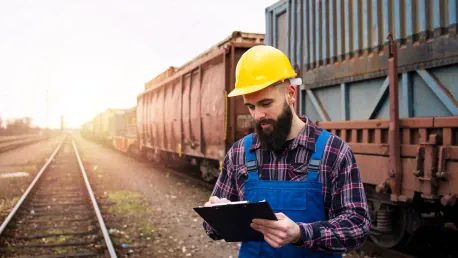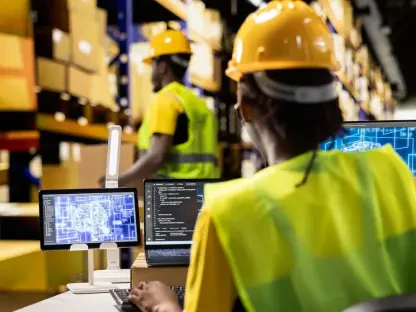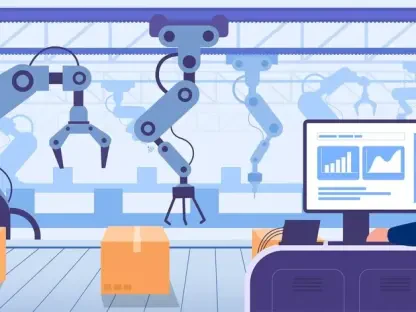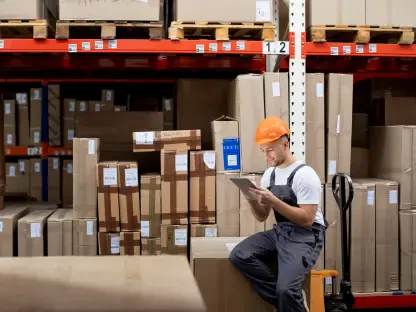The freight rail industry, a crucial component of global logistics, has lagged behind other transport sectors in embracing digital transformation. As safety and efficiency become paramount, the introduction of real-time monitoring technologies is poised to revolutionize industry practices. The industry’s reliance on obsolete technologies has led to significant inefficiencies and risks, making the need for modern solutions more pressing than ever.
The State of Freight Rail Technology
Lag in Digital Adoption
Despite advancements in fields such as aviation, automotive, mining, and shipping, freight rail has continued to rely on dated technologies from the 1980s. This stands in stark contrast to other industries that have embraced digital technologies like AI, IoT, and real-time monitoring to enhance operational efficiency and safety. The continued dependence on antiquated systems in freight rail has hindered progress and left the sector vulnerable to operational and safety inefficiencies. The slow pace of technological adoption in freight rail has been a critical barrier to achieving modern standards of efficiency and safety, much needed in today’s fast-paced logistics environment.
The urgency for digital transformation in freight rail is underscored by the growing complexities and demands of global logistics. As other sectors have demonstrated, embracing modern technologies can significantly enhance operational performance. However, the freight rail industry remains entrenched in systems that lack the capacity to meet contemporary demands. This digital lag creates a substantial gap in the industry’s ability to ensure timely and secure delivery of goods, which is vital for maintaining the smooth flow of global supply chains.
Consequences of Obsolete Systems
The reliance on outdated technologies in the freight rail industry has had dire consequences, including catastrophic derailments and operational delays. These incidents not only pose significant safety risks but also result in substantial economic losses and disruptions to supply chains. The inability to effectively monitor and manage operations in real time has left the industry vulnerable to unforeseen events that could have been prevented with modern technology. The propensity for system failures and inefficiencies is a direct result of the outdated infrastructure and monitoring practices that still dominate the sector.
The repercussions extend beyond immediate safety and operational concerns. The longstanding use of obsolete systems has eroded stakeholder confidence and highlighted the imperative for modernization. Incidents such as derailments underscore the urgent need for overhauling the current infrastructure with advanced technologies capable of providing accurate and timely information. The frequency and severity of these events, facilitated by the lack of modern monitoring solutions, make it clear that the current trajectory is unsustainable. Without adopting real-time monitoring technologies, the freight rail industry risks further degradation of service quality and an increased likelihood of avoidable accidents.
Innovations in Monitoring Technologies
Introduction of Transend®
Transdiagnostics has introduced Transend®, a product designed to address the inefficiencies and safety concerns plaguing the freight rail industry. Utilizing advanced sensors that attach to railcars via magnets, Transend® offers 24/7 real-time monitoring. This innovative approach marks a significant departure from traditional methods, providing a continuous stream of accurate data on various aspects of railcar performance and track conditions. The implementation of Transend® represents a transformative step towards embracing digital innovation in freight rail, bringing it in line with more technologically advanced sectors.
Transend® harnesses the power of real-time data collection and analysis to deliver actionable insights to train crews and operators. This constant flow of information encompasses critical metrics such as track temperature, force, and noise, which are vital for ensuring safe and efficient operations. By providing instant, Cloud-based connectivity for alerts and predictive diagnostics, Transend® enables proactive maintenance and timely interventions. The technology’s capacity to differentiate between critical alarms and routine maintenance data enhances decision-making processes and minimizes the risk of human error. The deployment of Transend® is a pivotal move towards modernizing the freight rail industry and enhancing its operational capabilities.
Advantages Over Traditional Systems
Unlike traditional systems that rely heavily on wayside detectors and ID tags on each railcar, Transend® offers a more dynamic and accurate solution. Wayside detectors, typically situated at fixed locations, often struggle with data accuracy and are limited by their placement, making them ineffective in certain terrains and over long distances. The inefficacy of these systems is particularly evident in the case of long freight trains, where radio signals may fail to transmit alerts properly. Transend® overcomes these limitations by providing real-time monitoring that is not constrained by geographical location, dramatically improving both safety and operational efficiency.
The versatility of Transend® allows for continuous surveillance of railcar conditions, leading to more precise and reliable data collection. This continuous monitoring significantly reduces the chances of undetected mechanical issues that could lead to accidents. Moreover, the predictive diagnostic capabilities of Transend® enable maintenance teams to address potential problems before they escalate, thereby reducing downtime and ensuring smoother operations. The contrast between the outdated, location-bound traditional systems and the comprehensive, real-time capabilities of Transend® highlights the immense potential for enhancing the safety and efficiency of freight rail operations through modern technology.
Real-World Applications and Benefits
Proven Efficacy Through Testing
The utility of Transend® has been extensively tested in real-world scenarios, such as its deployment on the Mary Valley Rattler. These field tests have demonstrated the system’s capacity to transform aging rail infrastructure into a modern, connected network. The use of cameras for real-time digital mapping and the early detection of issues is a substantial upgrade from traditional manual inspection methods. Transend® has proven its ability to deliver consistent, precise monitoring, showcasing its effectiveness in tracking key metrics and offering actionable insights that can preemptively address potential problems.
The successful testing has validated Transend® as a viable solution for widespread industry application. The field tests highlighted the system’s ability to operate reliably in diverse conditions, making it suitable for various rail networks across different geographies. The insights gained from these real-world applications have helped refine Transend®, ensuring its robustness and reliability. This proven efficacy is a critical factor in driving broader adoption, as operators can clearly see the tangible benefits of implementing the system. The capability of Transend® to integrate seamlessly with existing rail infrastructure while providing advanced monitoring solutions positions it as a pivotal tool for modernizing the industry.
Preventing Derailments
The potential of Transend® to prevent derailments underscores its life-saving capabilities. By offering early alerts and predictive diagnostics, the system can identify and address issues before they escalate into serious incidents. The tragic derailment in East Palestine, Ohio, was an example of how traditional detection methods failed to provide timely warnings, resulting in catastrophic consequences. Transend®’s ability to provide instant alerts based on real-time data could have prevented such an incident, highlighting the crucial role of advanced monitoring technology in ensuring rail safety.
The adoption of real-time monitoring solutions like Transend® is vital for mitigating the risks associated with operational failures. By continuously gathering and analyzing data, the system can detect anomalies and predict potential points of failure, enabling proactive maintenance and immediate response to emerging threats. The ability to differentiate between routine and critical issues ensures that significant threats are prioritized and addressed swiftly. Preventing derailments not only saves lives but also protects the significant economic assets involved in freight rail operations. The proactive capabilities of Transend® mark a considerable advancement in rail safety, offering a promising solution to one of the industry’s most pressing challenges.
Pushing for Industry-Wide Change
Advocacy for Modernization
Industry experts have been vocal about the necessity for adopting real-time monitoring technologies in freight rail. The advocacy for modernization is driven by the clear benefits these technologies offer in terms of safety and operational efficiencies. Experts emphasize the importance of proactive safety measures and operational improvements that modern technologies can provide. The shift from outdated systems to advanced, real-time monitoring solutions is seen as essential for elevating the industry to contemporary standards. The chorus for change spans across stakeholders, from regulators to operators, all recognizing the critical need for technological advancements.
The collective call for modernization is also fueled by the understanding that the risks posed by relying on obsolete systems are no longer acceptable. The increasing demand for timely and safe delivery of goods necessitates the adoption of advanced monitoring solutions capable of meeting these demands. The industry-wide recognition of these needs is driving a momentum towards embracing technologies like Transend®. This advocacy is further amplified by the demonstrated success of real-time monitoring systems in other transport sectors, serving as a compelling model for the rail industry to follow. As the push for modernization gains traction, the adoption of real-time monitoring technologies is poised to become a standard practice across the industry.
Regulatory Momentum
The regulatory landscape is evolving to support the shift towards modern technology in freight rail. Proposed regulations in the U.S. are set to enhance safety through stricter monitoring and real-time data reporting. These regulations are designed to prevent incidents like the East Palestine derailment and ensure that rail operations adhere to the highest safety standards. The push for regulatory changes is a response to the growing recognition that the current state of freight rail technology is insufficient to meet modern safety requirements. By mandating the adoption of advanced monitoring systems, regulators aim to foster a safer and more efficient rail network.
The alignment of regulatory momentum with industry advocacy creates a conducive environment for technological advancements. The new regulations not only compel operators to upgrade their systems but also provide a framework for implementing these changes systematically. The emphasis on real-time data reporting and stricter monitoring protocols is expected to drive significant improvements in operational safety and efficiency. The regulatory push is a critical driver for change, ensuring that the adoption of real-time monitoring technologies like Transend® is not just an option but a necessity for compliance and continued operational excellence. The harmonization of regulatory initiatives and industry efforts is setting the stage for a new era in freight rail operations.
Economic and Operational Impact
Cost and Efficiency Benefits
The economic and operational benefits of real-time monitoring technologies like Transend® are substantial. By providing accurate and timely data, these systems enable more informed decision-making, leading to reduced downtime and increased efficiency. The ability to predict and prevent mechanical failures means that maintenance can be scheduled proactively, reducing the incidence of unexpected breakdowns that disrupt operations. This predictive capability translates into significant cost savings, as it reduces the need for emergency repairs and extends the lifespan of railcar components.
Moreover, the enhanced reliability afforded by real-time monitoring improves overall network performance, ensuring that goods are delivered on time and in good condition. This reliability is crucial for maintaining the competitiveness of rail transport in the broader logistics market. The economic benefits are further amplified by the reduction in accidents and associated costs, including repairs, legal liabilities, and service disruptions. The cumulative effect of these savings and efficiencies enhances the bottom line for freight rail operators, making the investment in modern monitoring technologies an economically sound decision.
Enhancing Stakeholder Value
The adoption of real-time monitoring technologies also brings significant benefits in terms of enhancing overall stakeholder value. By improving safety and operational efficiency, these technologies contribute to higher levels of customer satisfaction. Shippers rely on the reliable and timely delivery of goods, and the enhanced performance of rail networks directly impacts their operations. Investors and shareholders also benefit from the reduced risk and increased profitability that come with the adoption of advanced monitoring systems. The clear demonstration of a commitment to safety and efficiency can enhance the reputation of freight rail operators, fostering greater trust and confidence among all stakeholders.
The comprehensive benefits of real-time monitoring create a strong case for its industry-wide adoption. By aligning technological advancements with stakeholder interests, freight rail operators can build a more resilient and efficient network. This alignment is essential for ensuring the long-term sustainability and growth of the industry. As real-time monitoring technologies like Transend® become more prevalent, they will redefine industry standards, driving continuous improvement and innovation. The positive impact on stakeholder value underscores the importance of embracing these advancements as a strategic priority for the future of freight rail.
Conclusion
The freight rail industry, an essential part of global logistics, has been slow to adopt digital transformation compared to other transportation sectors. As safety and efficiency become increasingly critical, the emergence of real-time monitoring technologies is set to significantly alter industry practices. The freight rail sector’s continued dependence on outdated technologies has resulted in considerable inefficiencies and potential risks, amplifying the necessity for modern solutions. Furthermore, incorporating advanced tracking systems can greatly enhance operational transparency and decision-making processes. Another key aspect is the potential to provide more accurate and timely data on cargo movement. This evolution could ultimately lead to reduced downtime, improved scheduling, and lower operational costs. Given these factors, it becomes evident that modernization in the freight rail industry is not just beneficial but essential. Addressing these challenges through cutting-edge technological advancements will undoubtedly position the freight rail sector to better meet the demands of the future.









